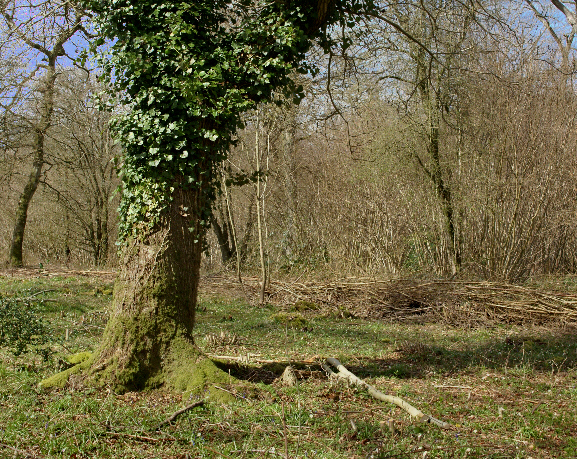
Hazel coppice with scattered mature oaks – a transitional woodland habitat ideal for species such as Pearl-bordered Fritillary and Duke of Burgundy – Adrian Hoskins
Transitional woodland
There are many different types of woodland in Britain, most of which are plantations of oak, beech or conifers, managed by the government agency Forest Enterprise. Only a small number of woods are now privately owned. Most of these are managed for timber, and a tiny number are coppiced.
In coppiced woods the trees are cut near the base of the trunk, which stimulates the growth of new shoots. The shoots are used mainly for hurdle making or charcoal production. Coppiced woodlands are of huge value as butterfly habitats. The regular cutting regime stimulates a continuous stable supply of larval foodplants and adult nectar sources. It also creates a warm sheltered environment that is ideal for butterflies.
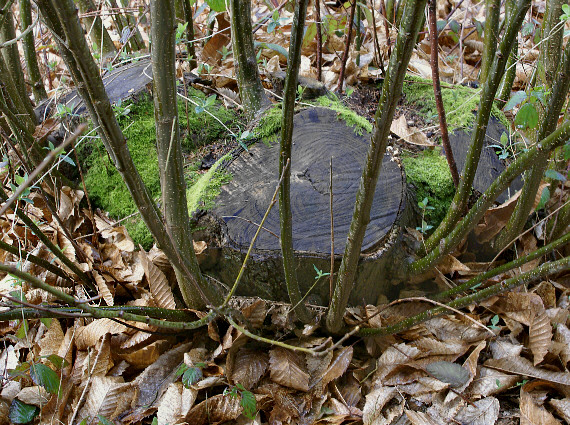
Sweet chestnut. After 8-12 years the shoots reach a diameter of about 8″, and are harvested again.
Trees which are traditionally coppiced include hazel, sweet chestnut and hornbeam. Hazel coppice is particularly valuable as a butterfly habitat. The fallen leaves decompose very quickly, exposing the ground to direct sunlight, which stimulates the germination of violets, primroses, bugle, trefoils, wild strawberry and other larval foodplants.
In sweet chestnut and hornbeam copses however the leaves decompose slowly, leaving a year-round carpet of dead leaves beneath the trees. This reduces light penetration and stifles germination of wild flowers. Consequently butterfly diversity and abundance is considerably lower than in actively coppiced hazel woodlands.
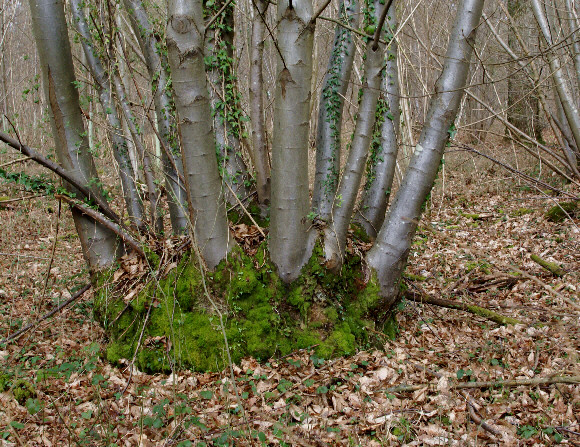
In most coppiced woodlands a small number of trees are allowed to reach maturity.
These include oak, ash and beech, sometimes supplemented by wych elm, lime or field maple. The shrub layer also invariably includes several incidental species such as buckthorn, hawthorn, blackthorn, sallow, holly and birch. A coppiced woodland thus includes a great diversity of trees, shrubs, herbaceous plants and grasses, providing foodplants for many caterpillars, and a variety of nectar sources for adult butterflies.
Butterflies confined mainly to transitional woodland habitats include Wood Whites, Heath Fritillaries, Pearl-bordered Fritillaries and Small Pearl-bordered Fritillaries. Many other species also use such places as supplementary or secondary habitats. These include Duke of Burgundy, Grizzled Skipper, Dingy Skipper, Holly Blue, Orange tip, Green-veined White, Brimstone, Peacock and Comma.
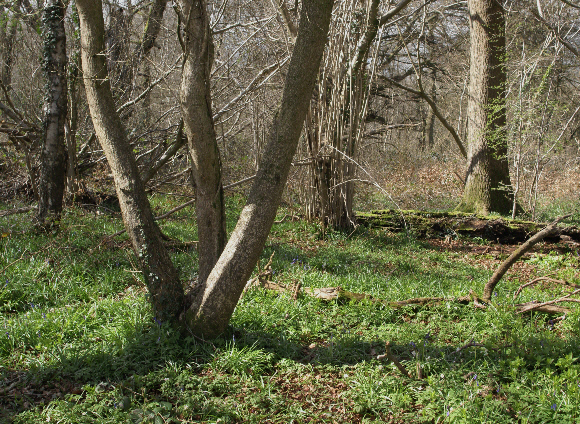
When coppiced woodland reaches maturity the amount of light reaching the forest floor diminishes, the herb layer virtually disappears, and butterflies are unable to continue breeding. Unfortunately most butterfly species have very poor powers of dispersal and rarely travel more than about 100-200 metres from their emergence site. It can take several years for successive generations to find a new breeding area. During the intervening years they struggle for survival, existing in only very low numbers, breeding along the edges of sunny woodland rides.
Woodland managers can help butterflies to win their struggle for survival by creating networks of sunny rides which can be used as migration corridors. If butterfly diversity and abundance are to be sustained it is vital that the coppice cycle is maintained. This ensures a varied age structure and diverse range of habitats, rich in the foodplants and nectar sources on which butterflies depend.
Conditions similar to those of coppiced woodland can be found in other transitional habitats such as the corridors of regularly cleared woodland beneath electricity pylons, or sunny railway embankments in wooded areas.
Ancient woodland
The New Forest in Hampshire is a unique area. It covers an area of over 57000 hectares which is largely managed by the government agency Forest Enterprise. It comprises of a mosaic of heaths, mires, pastures, conifer plantations and ancient oak / beech forest.
Records show that a century or two ago it was the richest area of Britain for butterflies, supporting a vast number of woodland, heathland and grassland species. Sadly that is no longer the case. Wild ponies and domestic cattle have been allowed to wander within the forest, and grazing has been so intensive that the herb layer of much of the area has disappeared, decimating butterfly populations.
Recently a more enlightened management policy has improved the situation. A small number of inclosures are now beginning to regain their former glory, with violets, bugle and other wild flowers reappearing. Consequently many species including Pearl-bordered, Dark Green and Silver-washed Fritillaries are now flourishing.
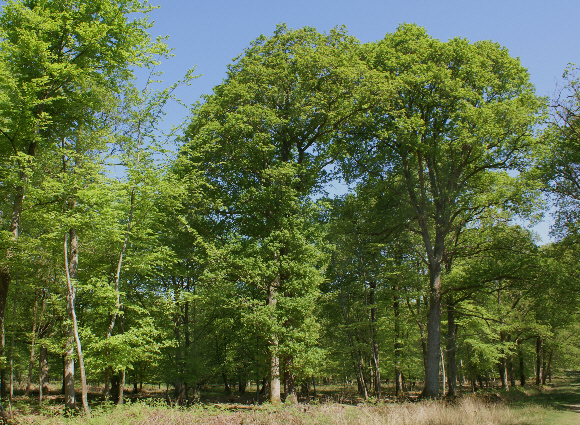 Mature oak woodland in the New Forest � Adrian Hoskins
Mature oak woodland in the New Forest � Adrian Hoskins
Broadleaf and conifer plantations
The vast majority of modern forests in Britain are plantations. Some are in private hands but most are state owned. These forests are typically broken up into small blocks of between 1-6 hectares in area, divided by firebreaks. Often several species of tree will be planted, but each individual block will consist of a monoculture of conifers such as pine, spruce, larch, cypress and fir trees.
Butterflies cannot survive in the gloom within conifer plantations, but when the trees are felled and sunlight once again reaches the forest floor, millions of dormant seeds germinate, carpeting the ground with violets, trefoils and bugle – the nectar sources and larval foodplants of butterflies. This abundance of food sources however is very short-lived, because within about 4 or 5 years, the new trees will have grown sufficiently to shade out the herb layer.
If butterfly colonies are to survive, it is vital that plantations are managed so that new clearings are created every year or two, to supply a continuous availability of suitable breeding habitat. It is also essential to give the butterflies a helping hand so that they can easily and quickly find their way to suitable new areas of breeding habitat. This can be done by creating wide sunlit rides which act as migration corridors between the forest blocks. Scalloping ride edges, and enlarging intersections provides additional temporary habitats where butterflies can breed.
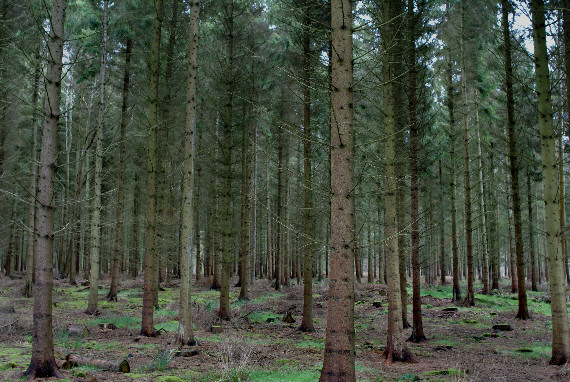
Pine plantations are dark dismal places where butterflies cannot survive – Adrian Hoskins
Timber nowadays offers little financial return, and this fact, together with increasing public demand for leisure facilities has brought about a change in Government forestry policy. The tendency now is for the plantations to be periodically thinned, rather than clear-felled and replanted, and for the woodlands to become retained for their amenity value – many former timber plantations are now Country Parks.
The edges of the tracks and rides in plantations are often planted with a narrow strip of amenity broadleaves such as oak, sallow, buckthorn, field maple and wych elm. There are also often a few ornamental species such as scarlet oak, sycamore, lime and cherry.
Most woodland blocks are edged with drainage ditches and small embankments, while other habitats may include small semi-permanent glades, grassy avenues, riversides and ponds. A modern woodland is thus comprised of a multitude of sub-habitats which support many native trees, shrubs and bushes. The structure of the woodland usually ensures that there is an abundance of sheltered sunny areas, supporting a rich variety of grasses and wildflowers growing along the ditches, embankments and ride edges.
Wide grassy forest rides can be thought of as “linear meadows”. Vetches, trefoils and violets growing along the ride edges are used as larval foodplants by many species, as are buckthorn, sallow, dogwood and holly. Nectar sources also abound – hemp agrimony, thistles, bugle and bramble each attracting numerous butterfly species.
The consequence of this rich botanical variety is that many plantations in southern Britain support not only true woodland butterflies such as Silver-washed Fritillary, Purple Emperor, White-letter Hairstreak, Purple Hairstreak and White Admiral, but also often have populations of species normally associated with scrubby grassland – e.g. Dark Green Fritillary, Brown Hairstreak, Grizzled Skipper, Dingy Skipper, Large Skipper, Marbled White, Meadow Brown, Ringlet and Gatekeeper.
Most species however exist at very low densities and there is an absolute and immediate need for landscape-level conservation management to be implemented to prevent their continuing decline and ultimate extinction.
